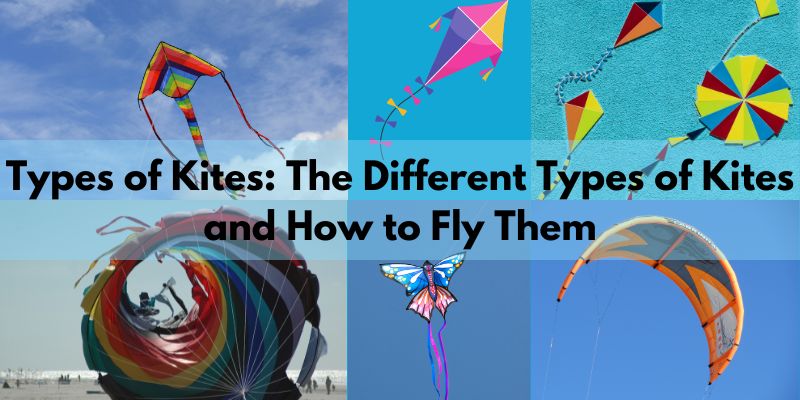Kites come in all shapes and sizes. From the simple diamond-shaped kite you flew as a child to the vast inflatable kites used in power kiting, there is a kite to suit every wind and every type of flight. But what are the different types of kites? How do they work? And what are they used for?
This blog post will look at the different types of kites and how to fly them. We will also discuss a few things to consider when choosing the best type of kite for your needs.
So, let’s get started!
The Different Types of Kites Around The World
Kites have been around for thousands of years and come in various shapes, sizes, and colours. They can be flown for fun or practical purposes such as measuring wind speed, lifting people or objects into the air, or generating power. Here are eight different types of kites design:
Delta Kites

Delta kites are winged kites that get their name from their triangular shape. Delta kites are one of the most popular thanks to their easy-flying nature and wide range of sizes. Delta kites typically have two or three lines attached to the wingtips and a single string attached to the nose.
The ability to fly in a wide range of wind speeds makes delta kites an excellent choice for both beginners and experienced flyers. Delta kites come in various colours and designs, making them a favorite among kids and adults. A delta kite is an excellent option if you’re looking to add a splash of colour to your yard or want an easy-to-fly kite.
Stunt Kites
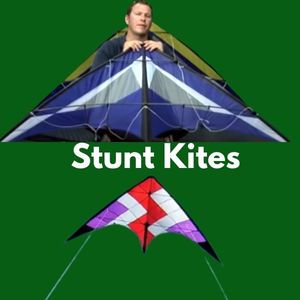
Stunt kites are a type of flying kite that is used for performing tricks. They are usually made from lightweight materials such as ripstop nylon or polyester and have a wingspan of 2-3 meters. Stunt kites are flown with two handles connected to the kite via lines.
The amount of line used depends on the wind conditions and the desired flying style. Stunt kites can reach up to 60 kilometres per hour when flown in strong winds. Performing tricks with a stunt kite requires great skill and practice.
Common tricks include loops, rolls, and stalls. Some pilots also use their kites to perform aerobatic manoeuvres such as spins and flips. With enough practice, stunt kite pilots can create an exciting show for onlookers.
Diamond Kites
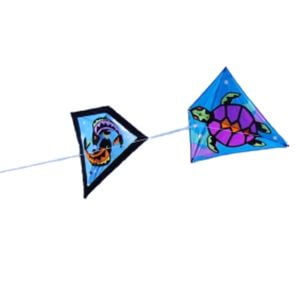
Diamond kites are single-line kites named for their typical diamond-shaped silhouette. They are simple to make and fly and are famous for kite enthusiasts. Although they can be flown in a wide range of wind conditions, they perform best in moderate to strong breezes.
Diamond kites are typically made from lightweight materials such as tissue paper or ripstop nylon. The frame is usually made from bamboo or carbon fiber rods, and the kite line is attached to the centre of the frame using a larks head knot.
When flying a diamond kite, it is essential to keep the kite steady and not allow it to twist or turn. This will help to prevent the kite from becoming tangled in the line. With practice, anyone can enjoy the simple pleasure of flying a diamond kite.
Foil Kites

Foil kites are a type of kite that does not have a frame. Instead, they are made of fabric that is stretched over vertical ribs. The ribs give the kite its shape and help hold the material in place. Foil kites are very lightweight and can be quickly launched into the air.
They are also very stable in the wind and can be flown in various wind conditions. Foil kites come in multiple sizes and shapes and can be decorated with colorful patterns. Flying a foil kite is a fun way to enjoy the outdoors and spend time with family and friends.
Traction Kites
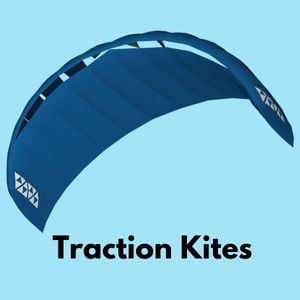
Traction kites are power kites designed to generate powerful pull. They are used in various sports, including kiteboarding, snowkiting, and power kiting. Traction kites come in different shapes and sizes, each with its specific set of features. The most crucial factor in choosing a traction kite is the wind conditions where it will be used.
Kitesurfing traction kites are typically larger and more powerful than those used for power kiting or snowkiting. They are designed to be flown in open water with strong winds. Snowkiting traction kites are smaller and have less power than kitesurfing kites. Power kiting traction kites are the smallest and have the least power. They are typically used in lighter winds and confined spaces.
Sled Kites
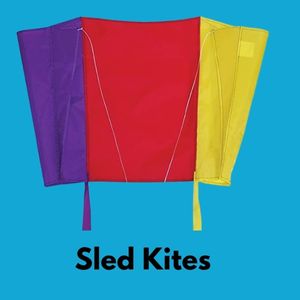
Sled kites are single-surface kites that stabilize from a set of vertical spars attached to the kite’s side. These spars keep the kite’s shape and allow it to withstand heavy winds. The sled kite’s simple design makes it easy to fly, and its stability makes it an excellent choice for beginners.
Experienced flyers can enjoy sled kites as well, thanks to their versatility. Sled kites can be flown in a wide range of winds, making them perfect for days when the wind is changing or gusty. They can also be flown in tight spaces, making them an excellent choice for those who want to enjoy kite flying without having a lot of space.
Cellular Kites
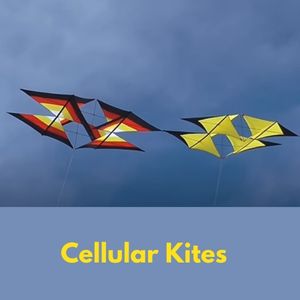
Cellular kites are multi-surface kites with a series of horizontal and vertical cells. These cells help to stabilize the kite and give it lift. Cellular kites are usually made from ripstop nylon or polyester and can be decorated with colorful patterns.
Cellular kites are slightly heavy and require stronger winds to fly. They are stable in the air and easy to control.
Rokkakus Kites

The Rokkakus kite, or fighting kite, is a traditional Japanese kite that is still flown today. It is made with a frame of bamboo and covered with washi paper. The kite has a tail made of streamers that flutter in the wind. There are also typically small weights attached to the bottom of the kite to help keep it stable in the air.
Rokkakus kites are flown solo or in groups and are often used in festivals and celebrations. In addition to being flown for fun, they are also used in religious ceremonies and as part of therapy for people with mental illness. Flying a Rokkakus kite can be a peaceful and meditative experience.
Types Of Kiteboarding Kites
Kiteboarding is a rapidly growing sport, also known as kitesurfing. Kitesurfing kites are classified into two types, i.e., foil kites and inflatable kites.
Although both are utilized in all kiteboarding categories, inflatable kites are better suited for kiteboarding in the waves, while foil kites are better suited for kiteboarding in mild winds.
Inflatable Kites

Inflatable kites are a type of kite that uses air pressure to inflate itself. The kite is made up of a series of bladders that are connected. When the kite is launched, the air pressure forces the bladders to fill up with air, and the kite takes on its shape.
Inflatable kites are usually made from materials such as nylon or polyester, which are strong and lightweight. Examples of inflatable kites are:
C-Kites
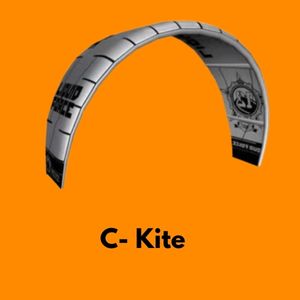
The C-kite is an old inflatable kite that has been around for centuries. They are used because of their direct feel and control. They generate much power and lift, providing good overall stability when unhooked. However, they have a short wind range and difficult water relaunch making them unsafe for beginners.
C-kites are C-shaped and have extended wingtips. They generally excel in new-school and freestyle riding performance, but their narrow wind range limits their versatility.
Hybrid Kites

The hybrid kite is the model of kite that cruisers and free riders like. It combines a C-kite’s sensation and powered turns with a bow kite’s safety and depowering qualities. Due to the harnesses that are attached to its leading edge, the hybrid kite is a supported leading edge (SLE) kite.
The hybrid kite offers outstanding depowering capabilities and a wide wind range thanks to its short wingtips and short bridle. A hybrid kite is a fantastic option for beginners because it is also relatively stable. In contrast to other kite models, the hybrid kite’s response time can be slow.
Bow Kites
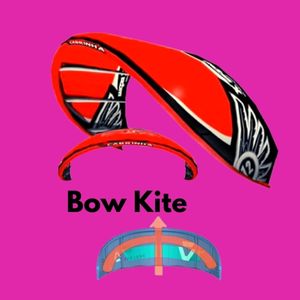
The bow kite is a popular model of kite that is used all over the world. It was introduced in the 2000s and had many advantages, such as being easy to depower, relaunch, and providing excellent upwind performance. The kite is also an SLE kite because its leading edge has bridle attachments. This is a flat kite type with a concave trailing edge.
While the bow kite has many benefits, it also has some disadvantages, one being that it is unsuitable for unhooked riding.
Delta Kites

Delta kites are power kites that combine the best features of C-kites and Delta kites. They are generally easy to relaunch and have a wide range of wind capabilities. Additionally, they slowly turn, making them safer for beginners. However, they also have a slow response time. Overall, Delta kites are suitable for kitesurfers, beginners, wave kitesurfers, big air kiteboarders, cruisers, and free riders.
Foil Kites
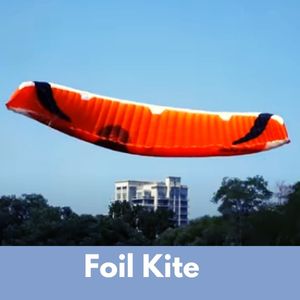
Foil kites are popular for kiteboarders and kitesurfers due to their many advantages. They have cells along their leading edge through which air flows, which helps to power and de-power the kite efficiently.
Additionally, foil kites are durable and can be landed on the beach without the help of a second person. Another advantage of foil kites is that they are available in 2, 3, and 4-line systems, which makes them a good choice for training, land, and snow kiteboarding.
Read Also: Kite Foil vs Kitesurf – In Depth Comparison
How to Fly Different Types of Kites
The launching and flying procedures for the vast majority of kites are almost the same. If you can fly one kite, you can fly another easily. The delta, diamond, and foil are all similar in their launch.
If you want to fly a kite on your own, here are some tips to help you get started:
- Before releasing the kite into the air, lay it flat on the ground with the trailing edge facing the wind and sprinkle some sand along the edge to keep it from blowing away.
- Walk directly into the wind to disentangle the lines, then turn around with one line in each hand and walk back towards the kite to attach them.
- To secure the lines to the kite, tie a lark’s head knot and pull it tight above the knots on the harness.
- You must have both hands on the bar and back up a few feet to tighten the lines before releasing the kite. With enough air, the kite will rise into the sky.
- If the wind is light, you will need the help of a partner. Let out 50 to 70 feet of line and have your partner hold the kite while you lengthen the line at one end. Pull the line as the other person releases the kite.
The sled kite is flown in a somewhat different manner. One of the key advantages is that it is straightforward to fly and takes little to no time to set up. All you have to do is unroll and unwrap the kite, wait for the air to fill it, and you’re ready to fly.
There may be minor differences in how you fly traction kites based on your vehicle or board or the sport you’re participating in. The conventional procedure for launching them without a vehicle or board is as follows:
- Create a symmetrical layout with your lines.
- Allow your kite to inflate after unwrapping it.
- To launch the kite, pull the upper halves of the handles.
Factors to Consider When Choosing the Best Type of Kite for Your Needs
Now that you know the different types of kites and how to fly them, it’s time to choose the best one for your needs. Here are some factors you should consider:
- The type of kiteboarding: If you want to do freestyle or big air tricks, a foil or bow kite is a good choice. If you wish to do waves or kitesurfing, a delta or foil kite is a good choice.
- The wind conditions: Choose a smaller kite if you’re kiting in strong winds. If you are kiting in lighter winds, choose a larger kite.
- Your experience level: If you’re a beginner, choose a kite that is easy to fly and has a wide wind range. Conversely, if you’re an experienced kiteboarder, you’ll need a more responsive kite.
- Budget: your budget will also play a role in determining the type of kite you can afford. Kites can range in price from around $100 to $1000.
With all of these factors in mind, you should be able to choose the best type of kite for your needs. So get out there and start flying!
FAQs
Which Kite Is Best for Beginners?
The best kite for a beginner is a delta kite. Delta kites are easy to fly and don’t require a lot of experience.
What Are the Best Types of Kites?
There is no definitive answer to this question, as it depends on what you are looking for in a kite. Some of the best types of kites include delta kites, foil kites, and bow kites.
What Shape of Kite Flies Best?
Again, there is no definitive answer to this question. Different kite shapes fly differently, depending on what you are looking for in a kite.
If you are just starting, we recommend getting a delta kite. Delta kites are easy to fly and don’t require a lot of experience.
What Is the Biggest and Most Popular Type of Kite?
The biggest and most popular type of kite is the power kite. Power kites are large kites that are usually flown with two lines. They are very powerful and can generate a lot of lift.
What Type of Kite Flies Best in Low Wind?
In low wind conditions, it is best to fly a kite with a lot of surface area. A large kite or a kite with a lot of fabric will give you the most lift in low wind conditions.
Are Bigger Kites Easier to Fly?
No, bigger kites are not necessarily easier to fly. They can be more challenging to fly because they generate a lot of lift and can be harder to control.
What Do You Call a Kite Without a Tail?
A kite without a tail is called a stingless kite. Stingless kites are more accessible to fly than kites with tails because they are more stable in the air.
Conclusion
As you can see, many different types of kites are available on the market. The type of kite you choose will depend on your experience level, what you are looking for in a kite, and the wind conditions. We hope this guide has helped you understand the different types of kites and how to fly them. Thanks for reading!

